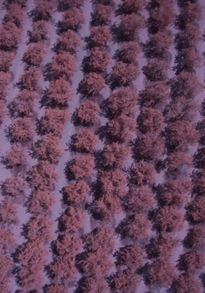
Aerial imaging can provide real-time information to growers regarding water usage and crop health. Within agriculture, these tools provide a valuable service for identifying problematic areas within fields, thereby increasing efficiencies for both small and large scale producers. Currently, most aerial imaging is conducted by flights with mid-elevation aircraft or satellites. These flights and corresponding images are usually conducted by a service company and provided on a weekly or monthly basis.
Autonomous or Unmanned Aerial Vehicles (UAVs) may provide a format in which more regular flight data can be obtained. Most discussions within agricultural settings have been focused around large fixed wing drones. However, smaller, less sophisticated and less autonomous UAVs could provide a useful platform for California farmers. These smaller UAVs would be less expensive to construct, may require less regulatory permitting, and provide a mobile platform that can be quickly deployed within a field setting. In these settings, small UAVs would have the ability to quickly monitor crops for water stress, nutrient management, and pest and disease epidemics.
A major barrier for small UAVs is camera/imager selection and processing. Currently, most work within crop stress management has focused on the use of thermal cameras that operate in the far-infrared spectrum (Maes and Steppe, 2012). These cameras are expensive, which inhibits the adoption of UAV technology. More commonly used spectral wavelengths, such as visible and near-infrared wavelengths can be used for other vegetation indices need to be researched to determine if they provide comparable results as thermal imaging. These imagers and indices are attractive to the end-user due to the lower cost to implement. With these challenges in mind, a research project sponsored by the University of California Agricultural and Natural Resource Competitive Grants Program was awarded to determine the feasibility of using small UAVs for perennial crop water stress analysis.
Project results over the past two years have utilized data collected from multiple flights conducted over an irrigation experiment within a mature almond orchard. Results from over 100 flights with simultaneously conducted stem water potential measurements (SWP) have found that normalized difference vegetation index is not an effective tool to monitor near-real time water stress within almonds. This is due to multiple challenges which include the growth stage of the plant, the distribution of stressed leaves within the canopy, effects of solar motion on the canopy reflectance, and the effects of UAVs vibration on image bi-directional reflectance distribution. These barriers are great enough that if solutions are not determined, small platform UAVs will not be able to detect near-real time water stress within perennial cropping systems.
Data collected in the 2016 crop year may have provided a breakthrough in the use of small UAVs. These flights have found a higher degree of image correlation when processing the image values differently. After the shaded surface area is removed from the image, the canopy’s image pixels are normalized to create a distribution. These distributions are then analyzed for their skewness (i.e. the shift to the left or right) and then compared to SWP measurements. Interestingly, this image processing has been found to correlate reasonably well with SWP (R2= 0.58) and may provide the ability to utilize lower cost imagers for water stress monitoring. Testing is ongoing.
To further share these results as well as other accomplishments within the project, a field day is being hosted on Thursday, June 1st near Los Banos, CA. Presentations on obtaining a license to fly UAVs, flight demonstrations, and perspectives from both growers and researchers who utilize this technology will be shared. The meeting is hosted at Bowles Farming Company located at 11609 Hereford Rd, Los Banos from 9:30 to 11:30AM.


Scott Hatcher
June 7, 2017Are the results of these 2016 studies published?
David Doll
June 7, 2017Scott,
Yes, our most recent update is available at the following link: http://www.sciencedirect.com/science/article/pii/S240589631631638X
Hope that helps,
David
Scott Hatcher
June 14, 2017Thanks Dr. Doll, much appreciated.
-Scott